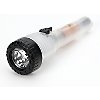 Someone once asked me, “Have you figured out if there’s a way to travel around the world without ever plugging into a wall socket? With/without a laptop?”
Someone once asked me, “Have you figured out if there’s a way to travel around the world without ever plugging into a wall socket? With/without a laptop?”
The second part of that question is the tricky part, but the first part is now not all that hard. For a trip through Peru this past December, I was almost a total solar-powered and wind-powered traveler, but I did have to carry one charger—for my camera. I’m currently looking for a way to ditch that one too, but it’s harder.
The first step to get rid of batteries and chargers is to carry the right flashlight. You can find one with a crank for pretty cheap, but many of these tend to be too bulky for a backpacker. A better bet is a shake flashlight that keeps going and going forever but is easy to stuff in a bag. I’ve carried one of these on multiple trips and use it at home too. Or there is such a thing as a Solar powered headlamp
For your cell phone, MP3 player, and other gadgets, there are multiple solar chargers out there, including the Solio Solar Charger pictured above. I don’t personally think the most expensive “magnesium” version of this is worth the premium, even though it does charge up a bit faster. Go with the cheaper one or look for alternatives that go for even less.
 Or you can go for the HyMini wind charger instead with the optional solar attachment. Then you’re covered rain or shine as long as you have sunlight OR a breeze. If you’re hiking through the mountains, you may have both. The Hymini comes with an attachment for a bike too, which means you’re generating power as you ride—pretty cool!
Or you can go for the HyMini wind charger instead with the optional solar attachment. Then you’re covered rain or shine as long as you have sunlight OR a breeze. If you’re hiking through the mountains, you may have both. The Hymini comes with an attachment for a bike too, which means you’re generating power as you ride—pretty cool!
My beloved SteriPen Traveler water purifier has kept hundreds of plastic water bottles off the streets, but it takes batteries. No problem, because you can buy a solar charger for those batteries that also doubles as a case for the SteriPen. It takes 6-8 hours for a full charge, but then that is enough to last for weeks of use.
Cameras are more difficult, however, because most either use some weird proprietary battery or they require plugging into a 110/220 socket to recharge. And as you know, you have to recharge often with digital cameras. There are items like the Callpod fueltank that can carry you over with the gadgets, but not something that requires the equivalent of A/C outlet power.
The problem is, you need more than 10 watts for this—which means for a regular camera charger or a laptop, you need a large solar panel. You start getting into bigger items like a$179 roll-up charger from Gaiam or one of those nifty but expensive Voltaic Generatorlaptop charger bags. Maybe you can justify 500 bucks if you’re running an NGO in the desert or you’re on a remote expedition somewhere, but otherwise it’s not easy to part with that much money just to be a good citizen.
Of course if you’re just going camping or living off the grid instead of vagabonding, then there are lots of other cool items you can use: crank radios, solar-recharged lamps, solar ovens, and more.
To see more reviews of travel gear like this, check out as well Tim Leffel's reviews at the weblog Practical Travel Gear


